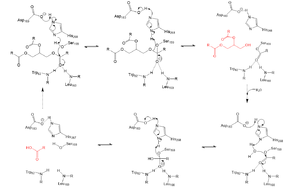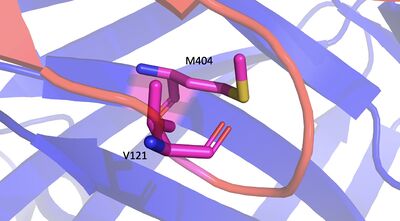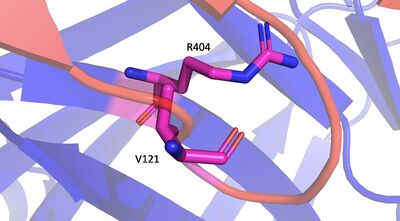User:Giselle Flores/Sandbox 1
From Proteopedia
(Difference between revisions)
| Line 5: | Line 5: | ||
==Introduction== | ==Introduction== | ||
| - | A [https://en.wikipedia.org/wiki/Lipase lipase] is an enzyme that is capable of catalyzing the [https://en.wikipedia.org/wiki/Hydrolysis hydrolysis] of fats/lipids which are consumed through oils. It is encoded by the [https://www.genecards.org/cgi-bin/carddisp.pl?gene=LPL p22 region in chromosome 8]. Once synthesized, it is secreted into the interstitial space in several tissues. The main site of action for LPL is in the [https://www.pnas.org/content/pnas/116/5/1480/F1.large.jpg capillary lumen] within muscle and adipose tissue. The function of this lipase is to hydrolyze [https://en.wikipedia.org/wiki/Triglyceride triglycerides] of very low density lipoproteins ([https://qph.fs.quoracdn.net/main-qimg-8e874e647baeb69b00203c47165247e2 VLDL]) and to aid in the delivery of lipid nutrients to vital tissues. The enzyme is commonly found on the surface of cells that line blood capillaries. Two different lipoproteins are essential to break down triglycerides. One of the lipoproteins is utilized to transport fat into the bloodstream from different organs. The lipoproteins essential, in the transport of fat from the intestine are referred to as [https://en.wikipedia.org/wiki/Chylomicron chylomicrons]. VLDL are utilized in carrying triglycerides from the liver into the bloodstream. The hydrolysis of triglycerides by lipoprotein lipase results in fat molecules | + | A [https://en.wikipedia.org/wiki/Lipase lipase] is an enzyme that is capable of catalyzing the [https://en.wikipedia.org/wiki/Hydrolysis hydrolysis] of fats/lipids which are consumed through oils. It is encoded by the [https://www.genecards.org/cgi-bin/carddisp.pl?gene=LPL p22 region in chromosome 8]. Once synthesized, it is secreted into the interstitial space in several tissues. The main site of action for LPL is in the [https://www.pnas.org/content/pnas/116/5/1480/F1.large.jpg capillary lumen] within muscle and adipose tissue. The function of this lipase is to hydrolyze [https://en.wikipedia.org/wiki/Triglyceride triglycerides] of very low density lipoproteins ([https://qph.fs.quoracdn.net/main-qimg-8e874e647baeb69b00203c47165247e2 VLDL]) and to aid in the delivery of lipid nutrients to vital tissues. The enzyme is commonly found on the surface of cells that line blood capillaries. Two different lipoproteins are essential to break down triglycerides. One of the lipoproteins is utilized to transport fat into the bloodstream from different organs. The lipoproteins essential, in the transport of fat from the intestine, are referred to as [https://en.wikipedia.org/wiki/Chylomicron chylomicrons]. VLDL are utilized in carrying triglycerides from the liver into the bloodstream. The hydrolysis of triglycerides by lipoprotein lipase results in fat molecules for future usage by the body as energy or stored in fatty tissue. |
| Line 13: | Line 13: | ||
Lipoprotein Lipase is assumed to only be active as a <scene name='87/877513/Lpl_dimer/1'>homodimer</scene>, however, previous studies have argued that the lipase can be active in its monomeric form. (https://www.ncbi.nlm.nih.gov/pmc/articles/PMC6442593/) The N-terminal domain of lipoprotein lipase is known to consist of an alpha/beta hydrolase domain, which is composed of six alpha helices and ten beta-strands. This domain creates an <scene name='87/877513/Secondary_structure/1'>alpha/beta hydrolase fold</scene>. The C-terminal domain of lipoprotein lipase is composed of twelve beta strands which form a “<scene name='87/877513/Secondary_structure/1'>barrel domain | Lipoprotein Lipase is assumed to only be active as a <scene name='87/877513/Lpl_dimer/1'>homodimer</scene>, however, previous studies have argued that the lipase can be active in its monomeric form. (https://www.ncbi.nlm.nih.gov/pmc/articles/PMC6442593/) The N-terminal domain of lipoprotein lipase is known to consist of an alpha/beta hydrolase domain, which is composed of six alpha helices and ten beta-strands. This domain creates an <scene name='87/877513/Secondary_structure/1'>alpha/beta hydrolase fold</scene>. The C-terminal domain of lipoprotein lipase is composed of twelve beta strands which form a “<scene name='87/877513/Secondary_structure/1'>barrel domain | ||
</scene>”. | </scene>”. | ||
| + | |||
| + | |||
==Mechanism== | ==Mechanism== | ||
Lipoprotein Lipase functions to catalyze the hydrolysis of one [https://en.wikipedia.org/wiki/Ester ester bond] of triglycerides. It does this by utilizing a simple [ https://en.wikipedia.org/wiki/Serine_hydrolase serine hydrolase] mechanism, in which it uses a <scene name='87/877516/Catalytic_triad_master/1'>Catalytic Triad</scene> composed of Asp183, His268, and Ser159 to catalyze the hydrolysis. His268 serves as a base catalyst by deprotonation of Ser159, which can then serve as the [https://en.wikipedia.org/wiki/Nucleophile nucleophile]. The transition state of the catalysis is stabilized by the <scene name='87/877516/Oxyanion_hole_master/1'>Oxyanion Hole</scene> composed of Trp82 and Leu160. The hydrolysis results in the formation of one free fatty acid and a glycerol with two fatty acid tails. | Lipoprotein Lipase functions to catalyze the hydrolysis of one [https://en.wikipedia.org/wiki/Ester ester bond] of triglycerides. It does this by utilizing a simple [ https://en.wikipedia.org/wiki/Serine_hydrolase serine hydrolase] mechanism, in which it uses a <scene name='87/877516/Catalytic_triad_master/1'>Catalytic Triad</scene> composed of Asp183, His268, and Ser159 to catalyze the hydrolysis. His268 serves as a base catalyst by deprotonation of Ser159, which can then serve as the [https://en.wikipedia.org/wiki/Nucleophile nucleophile]. The transition state of the catalysis is stabilized by the <scene name='87/877516/Oxyanion_hole_master/1'>Oxyanion Hole</scene> composed of Trp82 and Leu160. The hydrolysis results in the formation of one free fatty acid and a glycerol with two fatty acid tails. | ||
[[Image:LPL_final_Mechanism.png|300 px|left|thumb|Serine hydrolase mechanism utilized by LPL to catalyze the breakdown of one ester bond of a triglyceride. Compounds colored red are the products of the hydrolysis.]] | [[Image:LPL_final_Mechanism.png|300 px|left|thumb|Serine hydrolase mechanism utilized by LPL to catalyze the breakdown of one ester bond of a triglyceride. Compounds colored red are the products of the hydrolysis.]] | ||
| + | |||
| + | |||
== Relevance & Disease == | == Relevance & Disease == | ||
| Line 23: | Line 27: | ||
[[Image:M404_No_Mutation_copy.jpg|400 px|right|thumb|No Mutation Image]] | [[Image:M404_No_Mutation_copy.jpg|400 px|right|thumb|No Mutation Image]] | ||
[[Image:M404ToR404Pymol_copy_2.jpg|400 px|right|thumb|Mutation Image]] | [[Image:M404ToR404Pymol_copy_2.jpg|400 px|right|thumb|Mutation Image]] | ||
| + | |||
| + | |||
| + | |||
== Structural highlights == | == Structural highlights == | ||
Revision as of 19:48, 19 April 2021
Lipoprotein Lipase LPL
| |||||||||||



